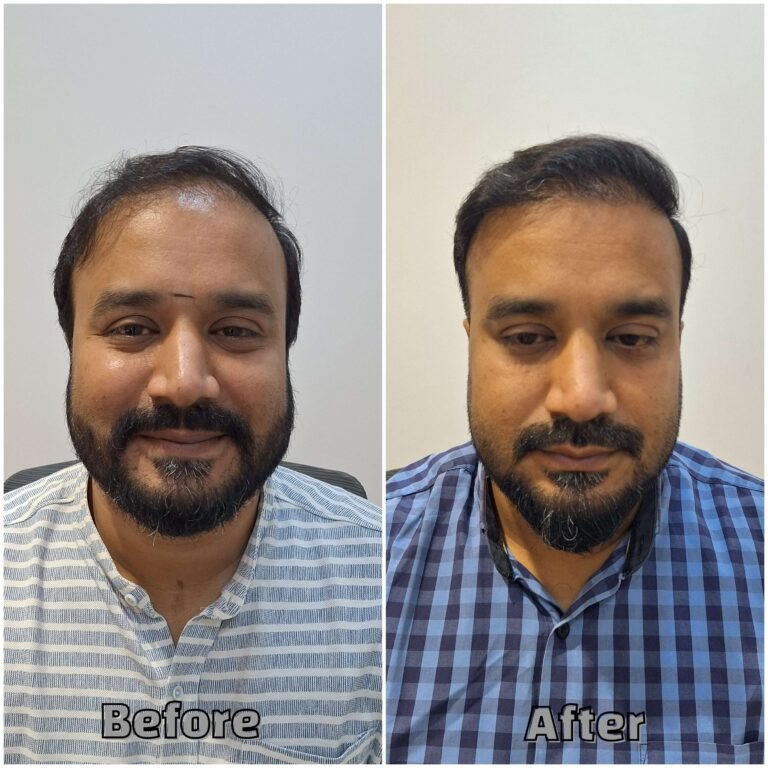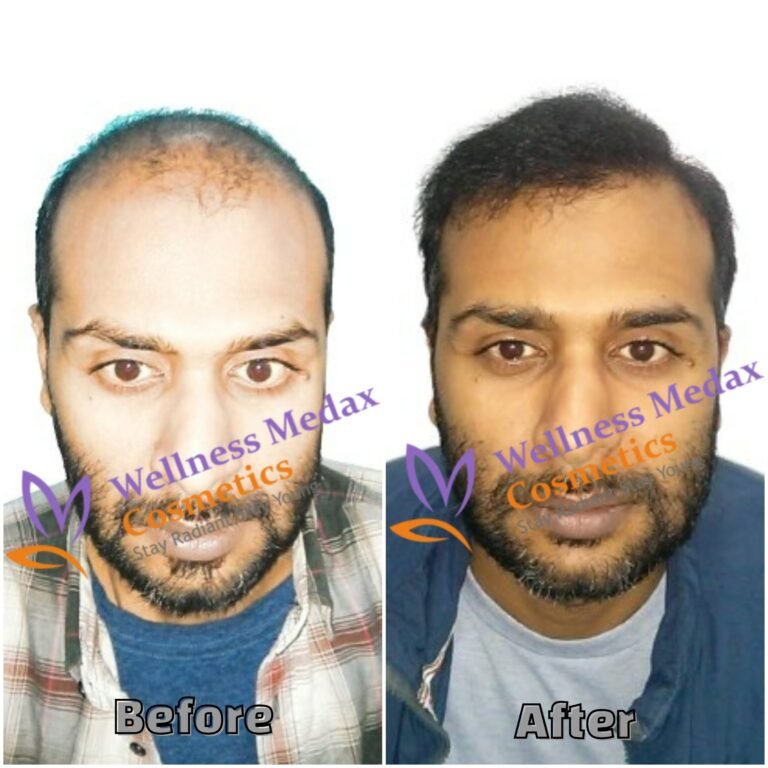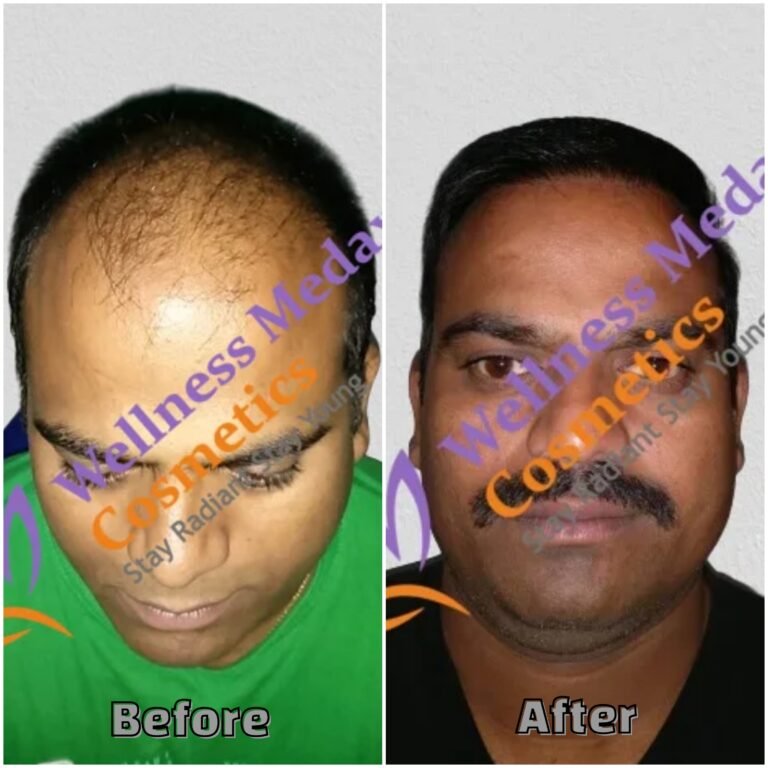Hair Transplant in Bangalore
Restore your Crowning Glory with Confidence – from Revitalizing Treatments to Transformative Transplants, Unlock the Secret to Lush, Luscious Locks!
Advantages of Hair Loss Treatments:
- Improved Confidence: Restoring hair density and coverage can significantly boost self-esteem and confidence for both men and women affected by hair loss.
- Natural Results: Advanced treatment options aim to replicate the natural appearance and growth patterns of hair, ensuring seamless integration with existing hair and a realistic outcome.
- Non-Invasive Options: Many hair loss treatments, such as topical medications, oral supplements, and low-level laser therapy (LLLT), are non-invasive, making them suitable for individuals seeking minimal downtime and recovery.
- Prevention of Further Hair Loss: Some treatments not only promote hair regrowth but also help prevent further hair loss, preserving existing hair and maintaining overall hair health.
- Customized Solutions: Hair loss treatments can be personalized to address individual concerns, taking into account factors such as the underlying cause of hair loss, hair type, and desired outcome.
Techniques of Hair Loss Treatments:
- Topical Medications: FDA-approved topical treatments, such as minoxidil (Rogaine), are applied directly to the scalp to promote hair regrowth and slow down hair loss. These medications are typically used once or twice daily.
- Oral Medications: Oral medications like finasteride (Propecia) work by blocking the hormone dihydrotestosterone (DHT), which is responsible for shrinking hair follicles in male pattern baldness. While primarily prescribed for men, finasteride may also be used off-label for certain cases of female pattern hair loss.
- Low-Level Laser Therapy (LLLT): LLLT devices emit low-level laser light that stimulates hair follicles, promoting hair growth and improving hair density. This non-invasive treatment option is available in the form of handheld devices or in-office treatments.
- Platelet-Rich Plasma (PRP) Therapy: PRP therapy involves injecting concentrated platelets from the patient’s blood into the scalp to stimulate hair follicle activity, promote hair growth, and improve hair thickness. It is often combined with other hair loss treatments for enhanced results.
- Hair Transplant Surgery: Hair transplant techniques, such as Follicular Unit Transplantation (FUT) and Follicular Unit Extraction (FUE), involve harvesting hair follicles from donor areas and transplanting them into balding or thinning areas of the scalp. This surgical approach provides permanent, natural-looking results.
- Regenerative Medicine: Emerging treatments, such as stem cell therapy and growth factor injections, harness the regenerative properties of stem cells and growth factors to promote hair growth and improve hair quality.
Follicular Unit Extraction (FUE) is a popular and advanced hair transplant technique known for its precision and natural-looking results. Here are the advantages and techniques associated with FUE hair transplant:
Advantages of FUE Hair Transplant:
Minimal Scarring: FUE hair transplant leaves minimal scarring as it involves extracting individual hair follicles from the donor area using small, circular punches. This results in tiny, dot-like scars that are virtually undetectable, making FUE a preferred option for those who prefer to wear their hair short.
Less Invasive: FUE is a less invasive procedure compared to traditional follicular unit transplantation (FUT), which involves removing a strip of scalp tissue. With FUE, there’s no need for sutures or stitches, leading to a quicker and more comfortable recovery.
Natural-Looking Results: FUE allows for the precise extraction and transplantation of individual hair follicles, mimicking the natural hair growth pattern. This technique results in hairlines and hair density that closely resemble natural hair, providing more aesthetically pleasing and seamless results.
Faster Healing Time: The small, punctate wounds created during FUE heal relatively quickly, typically within a week or two. Patients can resume their normal activities sooner compared to FUT, which may require a longer recovery period due to the linear scar at the donor site.
Versatility: FUE hair transplant can be used to treat various degrees of hair loss, from minor thinning to advanced baldness. It is suitable for both men and women and can be performed on different areas of the scalp, including the hairline, crown, and temples.
Techniques of FUE Hair Transplant:
Donor Area Preparation: The donor area, usually the back or sides of the scalp where hair is genetically resistant to balding, is trimmed to facilitate the extraction process. Local anesthesia is administered to ensure patient comfort during the procedure.
Follicle Extraction: Using a specialized punch tool, individual hair follicles are carefully extracted from the donor area. The size of the punch tool may vary depending on the characteristics of the patient’s hair and the expertise of the surgeon.
Graft Preparation: Once extracted, the harvested follicles are meticulously examined and prepared for transplantation. They are sorted and trimmed to ensure uniformity and viability before being implanted into the recipient area.
Recipient Site Creation: Tiny incisions are made in the recipient area of the scalp, where the hair follicles will be transplanted. The angle, depth, and distribution of these incisions are critical for achieving natural-looking results and optimal hair growth.
Follicle Implantation: The prepared follicles are then carefully inserted into the recipient incisions, ensuring proper orientation and placement to mimic the natural hair growth pattern. This meticulous process requires precision and artistry to achieve the desired aesthetic outcome.
Overall, FUE hair transplant offers numerous advantages, including minimal scarring, less invasiveness, natural-looking results, faster healing time, and versatility. With its advanced techniques and skilled practitioners, FUE has become a popular choice for individuals seeking effective and aesthetically pleasing solutions for hair restoration.
A. Hair transplantation is an increasingly popular and dependable approach for addressing alopecia. At Wellness Medax Cosmetics ,hair transplantation, through follicular-unit grafting also popularly known as Follicular Unit Extraction (FUE), is the practiced surgical method for individuals with specific forms of alopecia seeking hair restoration. The latest development in FUE (Follicular Unit Extraction) technique is the use of specialized, smaller rotary devices for extraction, leading to more precise and minimally invasive procedures. This enhanced precision helps achieve a more natural hairline and reduces scalp trauma. This procedure assists them in attaining a more natural and voluminous hair appearance. Currently, FUE represents the more common approach due to its potential advantages over FUT (the STRIP technique), which include:
- An increased number of harvestable grafts.
- Less apparent scarring.
- Donor site laxity and density are not a significant deterrent
- Less postoperative pain
- Decreased postoperative healing time
- Allows targeting of follicular groups of a specific size or hairs with a specific diameter or pigmentation; and
- The surgeon can target hairs outside the typical donor site, such as the parietal scalp, chest, back, and beard if needed.
A. The success of hair transplantation surgeries for androgenetic alopecia is evaluated by postoperative long-term outcomes. Staff at Wellness Medax Cosmetics recognise surgical intervention, medication treatment, and long-term postoperative plans are crucial for enhancing surgical outcomes. The initial recovery period that includes post operative mild pain and swelling can be for about 5 days to a week. The result after hair transplant in seen in stages over many months.
Clinically, mild, non-irritating shampoo should be used daily until scalp scabs fall off, avoiding direct contact with high-pressure water. In the first week post-surgery, gentle fingertip massage should be used to remove scalp scabs If scabs persist after a week, emollient oil can be applied with slightly more pressure to promote scab removal and healing, enhancing transplant survival rates Difficult-to-remove scabs should be addressed at the clinic to prevent transplant loss. Since it takes about six months to a year to achieve satisfactory postoperative appearance, patients should not worry about their appearance during recovery and the final outcome.
The recovery (result) period of hair transplantation surgery is long, and the planted hair has the process of shedding and re-growing, during which problems such as redness of the scalp may occur and therefore, we instruct patients to cover the surgical area to reduce the patient’s postoperative waiting period. Patients should understand that loss of the implanted hairs typically occurs after several days and may take several months to grow. There may also be surrounding native hair loss at the donor or recipient site, and this “shock loss” is transient and to expect a full recovery after a few months.
A. Hair transplantation is one of the most rapidly evolving procedures in aesthetic surgery, accompanied by regular improvement in techniques. The recovery (result) period of hair transplantation surgery is long, and the planted hair has the process of shedding and re-growing, during which problems such as redness of the scalp may occur and therefore, we instruct patients to cover the surgical area to reduce the patient’s postoperative waiting period. Patients should understand that loss of the implanted hairs typically occurs after several days and may take several months to grow. The patients are followed up to look for the time period of initiation of hair growth which is typically after 3 months, the final growth is achieved at the end of 9–12 months.
A. Swelling or oedema of forehead or eyelids is a common consequence of hair transplantation surgery, especially 2–6 days after the operation. Physical measures like position of head during sleeping, application of occlusion bands or ice packs is also advised.







